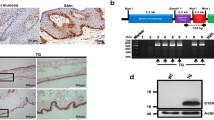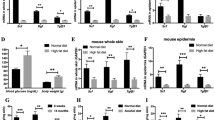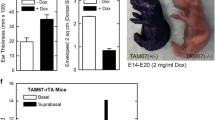Abstract
Fatty acids are shown to be important in various skin functions. Fatty acid binding protein (FABP) is postulated to serve as a lipid shuttle, solubilizing hydrophobic fatty acids and delivering them to the appropriate metabolic system. Among the FABP family proteins, epidermal-type FABP (E-FABP) is solely expressed in keratinocyte but its specific role in skin is not yet fully established. We found an elevated expression of E-FABP in regenerative keratinocytes of healing wounds. However, E-FABP null mice showed no marked differences compared to wild type mice in the process of wound closure, in vivo. On the other hand, in keratinocyte culture, E-FABP gene disruption decreased the cell motility, but did not affect the cell proliferation. E-FABP deletion may be compensated for in vivo by the microenvironment comprised of various cells such as fibroblasts and endothelial cells around the wound. Our analyses suggest that the E-FABP elevation may be necessary for the activation of cell motility within regenerative epidermis during wound healing.
Similar content being viewed by others
References
Coe NR, Bernlohr DA: Physiological properties and functions of intracellular fatty acid-binding proteins. Biochim Biophys Acta 1391: 287–306, 1998
Siegenthaler G, Hotz R, Chatellard-Gruaz D, Jaconi S, Saurat JH: Characterization and expression of a novel human fatty acid-binding protein: The epidermal type (E-FABP). Biochem Biophys Res Commun 190: 482–487, 1993
Owada Y, Yoshimoto T, Kondo H: Spatio-temporally differential expression of genes for three members of fatty acid binding proteins in developing and mature rat brains. J Chem Neuroanat 12: 113–122, 1996
O'Shaughnessy RF, Seery JP, Celis JE, Frischauf A, Watt FM: PA-FABP, a novel marker of human epidermal transit amplifying cells revealed by 2D protein gel electrophoresis and cDNA array hybridisation. FEBS Lett 486: 149–154, 2000
Hansen HS, Jensen B: Essential function of linoleic acid esterified in acylglucosylceramide and acylceramide in maintaining the epidermal water permeability barrier. Evidence from feeding studies with oleate, linoleate, arachidonate, columbinate and alpha-linolenate. Biochim Biophys Acta 834: 357–363, 1985.
Lowe NJ, Stoughton RB: Essential fatty acid deficient hairless mouse: A model of chronic epidermal hyperproliferation. Br J Dermatol 96: 155–162, 1977
Zamboni S, Zanetti G, Grosso G, Ambrosio GB, Gozzetti S, Peserico A: Dietary behaviour in psoriatic patients. Acta Derm Venereol Suppl (Stockh) 146: 182–183, 1989
Kragballe K, Fogh K: A low-fat diet supplemented with dietary fish oil (Max-EPA) results in improvement of psoriasis and in formation of leukotriene B5. Acta Derm Venereol 69: 23–28, 1989
Mayser P, Grimm H, Grimminger F: n−3 fatty acids in psoriasis. Br J Nutr 87(Suppl 1): S77–S82, 2002
Jensen M, Groth L, Holmer G, Hansen HS, Fullerton A: The potential of the essential fatty acid-deficient hairless rat as a psoriasis screening model for topical anti-proliferative drugs. Skin Pharmacol Appl Skin Physiol 15: 401–413, 2002
Zhu AJ, Haase I, Watt FM: Signaling via beta1 integrins and mitogen-activated protein kinase determines human epidermal stem cell fate in vitro. Proc Natl Acad Sci USA 96: 6728–6733, 1999
Owada Y, Takano H, Yamanaka H, Kobayashi H, Sugitani Y, Tomioka Y, Suzuki I, Suzuki R, Terui T, Mizugaki M, Tagami H, Noda T, Kondo H: Altered water barrier function in epidermal-type fatty acid binding protein-deficient mice. J Invest Dermatol 118: 430–435, 2002
Tan NS, Shaw NS, Vinckenbosch N, Liu P, Yasmin R, Desvergne B, Wahli W, Noy N: Selective cooperation between fatty acid binding proteins and peroxisome proliferator-activated receptors in regulating transcription. Mol Cell Biol 22: 5114–5127, 2002
Mansbridge JN, Knapp AM: Changes in keratinocyte maturation during wound healing. J Invest Dermatol 89: 253–263, 1987
Iizuka H, Ishida-Yamamoto A, Honda H: Epidermal remodelling in psoriasis. Br J Dermatol 135: 433–438, 1996
Martin P: Wound healing-aiming for perfect skin regeneration. Science 276: 75–81, 1997
Okuyama R, Nguyen BC, Talora C, Ogawa E, Tommasi di Vignano A, Lioumi M, Chiorino G, Tagami H, Woo M, Dotto GP: High commitment of embryonic keratinocytes to terminal differentiation through a Notch1-caspase 3 regulatory mechanism. Dev Cell 6: 551–562, 2004.
Roop D: Defects in the barrier. Science 267: 474–475, 1995
Fournier NC, Rahim M: Control of energy production in the heart: A new function for fatty acid binding protein. Biochemistry 24: 2387–2396, 1985
Donehower LA, Harvey M, Slagle BL, McArthur MJ, Montgomery CA Jr, Butel JS, Bradley A: Mice deficient for p 53 are developmentally normal but susceptible to spontaneous tumours. Nature 356: 215–221, 1992
Rappolee DA, Mark D, Banda MJ, Werb Z: Wound macrophages express TGF-alpha and other growth factors in vivo: Analysis by mRNA phenotyping. Science 241: 708–712, 1988
Marikovsky M, Breuing K, Liu PY, Eriksson E, Higashiyama S, Farber P, Abraham J, Klagsbrun M: Appearance of heparin-binding EGF-like growth factor in wound fluid as a response to injury. Proc Natl Acad Sci USA 90: 3889–3893, 1993
Werner S, Peters KG, Longaker MT, Fuller-Pace F, Banda MJ, Williams LT: Large induction of keratinocyte growth factor expression in the dermis during wound healing. Proc Natl Acad Sci USA 89: 6896–6900, 1992
Hulsey TK, O'Neill JA, Neblett WR, Meng HC: Experimental wound healing in essential fatty acid deficiency. J Pediatr Surg 15: 505–508, 1980
Caffrey BB, Jonsson HT Jr: Role of essential fatty acids in cutaneous wound healing in rats. Prog Lipid Res 20: 641–647, 1981
Murphy EJ: L-FABP and I-FABP expression increase NBD-stearate uptake and cytoplasmic diffusion in L cells. Am J Physiol 275: G244–G249, 1998
Schaap FG, Binas B, Danneberg H, van der Vusse GJ, Glatz JF: Impaired long-chain fatty acid utilization by cardiac myocytes isolated from mice lacking the heart-type fatty acid binding protein gene. Circ Res 85: 329–337, 1999
Michalik L, Desvergne B, Tan NS, Basu-Modak S, Escher P, Rieusset J, Peters JM, Kaya G, Gonzalez FJ, Zakany J, Metzger D, Chambon P, Duboule D, Wahli W: Impaired skin wound healing in peroxisome proliferator-activated receptor (PPAR)alpha and PPARbeta mutant mice. J Cell Biol 154: 799–814, 2001
Author information
Authors and Affiliations
Corresponding author
Rights and permissions
About this article
Cite this article
Kusakari, Y., Ogawa, E., Owada, Y. et al. Decreased keratinocyte motility in skin wound on mice lacking the epidermal fatty acid binding protein gene. Mol Cell Biochem 284, 183–188 (2006). https://doi.org/10.1007/s11010-005-9048-8
Received:
Accepted:
Published:
Issue Date:
DOI: https://doi.org/10.1007/s11010-005-9048-8




